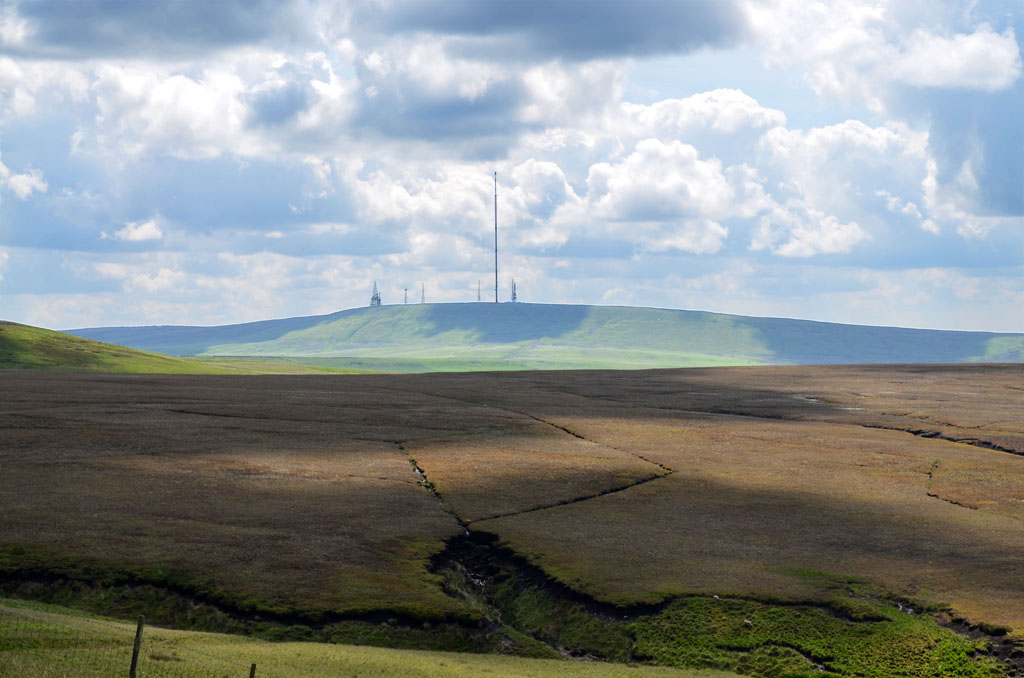The Winter Hill trespass was organised when the landowner Colonel Ainsworth of Smithills HallSmithills Hall in Bolton, Greater Manchester, is one of the oldest manor houses in the northwest of England, dating in parts from the 15th century. decided to close a track leading to Winter Hill in 1896. He was denying the right of access to the local population, who had used the path for generations to walk in the fresh air and enjoy the countryside. Ainsworth was prepared to use force to keep walkers off his property. He built a gate to block the road and erected signs warning that he would prosecute trespassers. Two protests were organised, in the second of which ten thousand people joined a procession to march over the track. But the protests were in vain, and access was denied in the courts.
Background
When the small coal pits on Winter HillThe high point of Rivington Moor in the West Pennine Moors is 1,496 feet high and has been the site of mining, a mass trespass, aeroplane disasters and murder. became exhausted the moors took on a new role; owners of extensive moorlandDominant landscape of Britain's uplands, including many of its national parks. estates saw potential for grouse shooting. The Ainsworths, who had bought Smithills Hall and its extensive landholding in the early 19th century, had exploited the coal, stone and water that was necessary for their bleachworks. Towards the end of the century the Ainsworths decided to close Smithills Moor to the public, and turn it into a private grouse shoot.[1]
Until then, Smithills Moor and Winter Hill had been informally accessed by workmen and locals who had used informal routes across the moor for generations. Coalpit Road was used by colliers who worked in the coal pits at the top of the moor, but in 1896 Colonel Richard Ainsworth decided to block the road with a locked gate.[1] He erected signs warning that trespassers would be prosecuted, and hired men to forcibly keep walkers off his property.[2]
Trespass

Wikimedia Commons
Opposition was instant, and the Bolton Branch of the Social Democratic Federation (SDF) proposed a march to the moors to test the right of way[3] on Sunday 6 September 1896. A large group assembled, and the police were present in force. An inspector was struck, a sergeant struck by stone, the land agent’s son was kicked. Stiles were broken down by a small group of protestors.[4]
The following Sunday an even larger protest took place in heavy rain. At least ten thousand people assembled on Halliwell Road to march over Coalpit Road in a procession that stretched for about two miles (3 km). It was led by members of the SDF, who had called for peace and order.[5] About sixty police were in attendance, but there was no violence, and the demonstration continued up the road onto the moor. The leaders’ names were taken, and Ainsworth announced he would fight the trespass in the High Court, and the protesters started a defence fund.[6]
Ten thousand went last Sunday but there’s room for thousands still!
O the moors are rare and bonny and the heather’s sweet and fine,
And the road across this hill top is the public’s – Yours and mine!
— Allen Clarke
In the courts, the rights of ordinary people were set against the landowner. The protest’s leaders were defended by Richard Pankhurst, but Ainsworth prevailed and was awarded £600 in costs.[7]
Another act of trespass for the freedom to roam the hills and moors took place on Kinder Scout in the Peak District of Derbyshire in April 1932. The Winter Hill trespass was mentioned in a parliamentary debate regarding “Right to Roam” legislation in 1999.[2] The “Right to Roam” was enacted in 2000 in the Countryside and Rights of Way Act 2000, more than 100 years after the mass trespass.
About a thousand walkers recreated the march from Halliwell to Winter Hill to commemorate the 125th anniversary of the trespass on Sunday 5 September 2021.[8]

